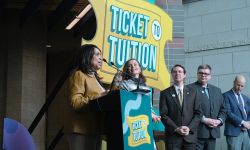First person: Teaching in COVID classroom ‘miraculous’ but ‘unsustainable’

In February, I signed up to be a substitute teacher. I was tired of being behind a computer all day, and I knew schools going back in person were in dire need of support.
What I’ve learned in six weeks as a middle school substitute has taught me that what teachers are doing now is daunting, miraculous and almost superhuman.
It’s also unsustainable.
I've never taught K-12 before, and it's a totally different thing than teaching college classes as I have for years. But I figured I am smart, I can adapt. I took a position as "building sub" at a metro Detroit middle school, where I had the chance to help students and be the eyes and ears for the teachers as the school transitioned in mid-February from remote learning to hybrid.
I absolutely LOVED being around these kids, and they desperately needed to hear they are doing great. They are resilient and amazing.
Related:
- Michigan education programs are training teachers, but hundreds aren’t passing the licensing exam
- Detroit schools found a way to attract teachers: Pay them more
- Michigan’s teacher of the year looks for silver linings as COVID fades
- Gov. Whitmer pitches financial incentives to recruit more Michigan teachers
- Michigan asked ex-teachers to return to school. In 3 weeks, 1,200 said yes.
- Teacher retirements soar in Michigan schools amid COVID pandemic
- Amid high teacher turnover in MI, audit finds failings in teacher support systems
But while I watched teachers performing miracles every day, I also saw the "churn" referenced in numerous articles, including Bridge Michigan’s report that 40 percent more teachers have retired so far this school year. I saw, daily, the stress felt by every staff member. The constant "what are we going to do, we don't have enough teachers!" The teachers frustrated at lack of resources, especially when it comes to aiding the children who need the most help.
I imagine what I've seen goes on at every single elementary and middle school in the state. The school I’m in has a very engaged staff and an amazingly caring administration that seems to know every student and family.
Still, many students are falling through the cracks faster than they can be pulled up and out.
Two weeks ago, the principal approached me about taking over a sixth-grade science class, where the teacher was out on long-term leave and the two-month long-term sub was now leaving, as well.
I am not a licensed teacher. I'd been subbing for less than a month. But I was Zoom-savvy. I understood how to manage a class. And those kids had already had two science teachers this school year; I knew I could be a steadying, compassionate force for them.
Despite being Ms. Hanus, sixth-grade science teacher, for all of 11 days, I can say with certainty that what the "real" teachers are doing is superhuman.
The hybrid model (with some students in classrooms and some following along at home) is not sustainable. Especially critical are classes like mine, where teachers have either retired midyear or taken long-term leave. There just aren't enough "long-term subs" willing or able to step into the quagmire that is teaching both online and in person simultaneously.
My several weeks of being a building "sub" allowed me to connect and communicate with the kids. I asked them how they were doing, helped them find assignments, got them back on task.
When I became a long-term substitute and began actually teaching the class, however, I no longer had the time to really stop and listen or provide much-needed support. I rush between opening Zoom, taking attendance and managing chat from students who are attending remotely. I’m constantly letting kids into the Zoom after their Internet dropped. I’m approving bathroom passes (kids can’t go to bathrooms between classes because of crowding and the need for contact tracing, and thus I have to fill out a pass every time saying which bathroom they’ll be going to).
Between periods, teachers are sanitizing the classroom instead of taking a bathroom break or a drink of water. Then they are monitoring the hallways to ensure students are distancing and getting into their classrooms instead of taking another lap around the school.
Oh, and there's the teaching. Teaching to a computer for 110-minute periods is grueling. The students and their needs often take a back seat to all the "must-dos" and protocols.
What teachers are doing right now is daunting, miraculous, and almost superhuman. It’s also unsustainable.
In many cases, the students attending in person are the ones who are most at risk and need the most attention. But they simply can’t get it in this teaching environment.
And those kids at home? When they raise a hand or private message me in chat sometimes I see it and sometimes I’m focused on the student in the back of the room raising his hand to go to the bathroom, or straining to hear a question from one of the students.
Unlike normal times, walking around the class and engaging one on one is hard to do both because of COVID protocols and because if I walk away from the screen I risk missing a question from the remote students. Private talks to correct behavior or to just check on a child that appears to be having a rough day? Very difficult in this environment of social distancing.
Don't get me wrong: I've seen so much innovation. But the energy it takes to do this, day in and day out, teaching to a screen and to a classroom – and often doing so with a lot of strikes against you – is exhausting beyond belief.
That anyone is criticizing teachers right now just floors me.
Realistically, what is needed for each of these teachers is an aide, a support person to do what I was doing as a building sub before taking on this class. But schools don’t have the budget for this. And even if they did, there just aren’t the bodies to fulfill this need. There are barely the bodies to do the superhuman work of leading classrooms.
I hope for the sake of all the educators, families and students that there are some brilliant minds coming up with a better way going into next school year.
Until then, I'm going to hang on to my hat and try to help these kids to the finish line of sixth grade.
Michigan Education Watch
Michigan Education Watch is made possible by generous financial support from:
Subscribe to Michigan Education Watch
See what new members are saying about why they donated to Bridge Michigan:
- “In order for this information to be accurate and unbiased it must be underwritten by its readers, not by special interests.” - Larry S.
- “Not many other media sources report on the topics Bridge does.” - Susan B.
- “Your journalism is outstanding and rare these days.” - Mark S.
If you want to ensure the future of nonpartisan, nonprofit Michigan journalism, please become a member today. You, too, will be asked why you donated and maybe we'll feature your quote next time!






